Deprecated: Creation of dynamic property WP_Term::$cat_ID is deprecated in /home2/acmhosting/public_html/content/wp-includes/category.php on line 378
Deprecated: Creation of dynamic property WP_Term::$category_count is deprecated in /home2/acmhosting/public_html/content/wp-includes/category.php on line 379
Deprecated: Creation of dynamic property WP_Term::$category_description is deprecated in /home2/acmhosting/public_html/content/wp-includes/category.php on line 380
Deprecated: Creation of dynamic property WP_Term::$cat_name is deprecated in /home2/acmhosting/public_html/content/wp-includes/category.php on line 381
Deprecated: Creation of dynamic property WP_Term::$category_nicename is deprecated in /home2/acmhosting/public_html/content/wp-includes/category.php on line 382
Deprecated: Creation of dynamic property WP_Term::$category_parent is deprecated in /home2/acmhosting/public_html/content/wp-includes/category.php on line 383
The post At the mercy of the rainforest appeared first on ACMCR.
]]>
Last Sunday, I set out at noon circumnavigate the trails of Bajo del Tigre. For most of the preceding week, some part of me felt had felt obligated to do so alone. Already had I joined several tour guides on the trails, learning the names and habits of some denizens that dotted the trails. At every hike’s conclusion, however, I felt an urge to circle back and experience the forest with full, undivided attention. From my hikes at home, I knew that hiking solo meant an in-tune-ness with the surrounding wildlife that no other experience could offer. Groups tend to make more noise, and the distracting chatter among individuals (guilty!) will scare off skittish animals, as well as distract you from the teeming biological world around you. In my home state’s comparatively homogenous biological zone this is true. It’s only doubly so in the Children’s Eternal Rainforest, where 0.00015% of the world’s land shelters seven different “life zones”.
But why, specifically, does the Children’s Eternal Rainforest demand this kind of unbridled, undivided attention? It’s easy: at any given moment, a chorus of chirps, squeals, and bonks — thank you, bellbird — combine in a sonorous but overwhelming number; a furious competition for your senses. Hearing each voice in the forest is difficult alone, but when you step into the Children’s Eternal Rainforest, you don’t know whether to keep your head toward the ground, where you spot the leafcutter ants, whose seamly lines stitch up the earth below you; to keep your head level, directed at the orange flight-streaks of butterflies that dive-bomb the flora in your periphery, only to vanish like an illusion when you turn your head to them; or to keep your head. toward the canopy, where the trees disguise the chirping residents that hide among them.
To task myself with observing each bird and bug that resides in the forest would be too difficult. I found it more appropriate to seek the noisiest, most distinct, member of the bunch. On this particular Sunday, I set out to find the bellbird. According to the Rainforest’s guides, it is difficult to spot the bellbird, despite its distinctive call. While I had been fortunate enough to see three — thanks to Greivin, our all-star forest guide — on my second day of work, I wished to find one with my own eyes.
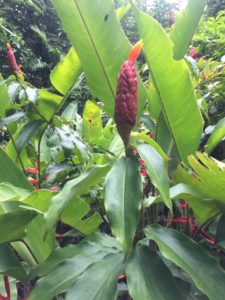 I entered the forest through the Sendero de los Niños, traveling westward along the mountain on top of which Bajo del Tigre is perched. The most eye-catching feature when entering the trail from this direction are the marvelous spiral gingers. At home, I struggle to differentiate plants from one another, but Costa Rican spiral gingers make this task notoriously simple. Not only are its golden-red fruits some of the few edible eats in the BEN (not that I’ve been brave enough to try), but the spiraled distribution of its leaves creates a gorgeous staircase that is equally functional and beautiful; the spread allows for each leaf to absorb the maximum amount of sunlight possible by staggering their growth pattern.
I entered the forest through the Sendero de los Niños, traveling westward along the mountain on top of which Bajo del Tigre is perched. The most eye-catching feature when entering the trail from this direction are the marvelous spiral gingers. At home, I struggle to differentiate plants from one another, but Costa Rican spiral gingers make this task notoriously simple. Not only are its golden-red fruits some of the few edible eats in the BEN (not that I’ve been brave enough to try), but the spiraled distribution of its leaves creates a gorgeous staircase that is equally functional and beautiful; the spread allows for each leaf to absorb the maximum amount of sunlight possible by staggering their growth pattern.
I continued traveling along the Sendero de Los Ninos as it wove itself into the Sendero del Mono, which slices a thin sliver of path from the mountain’s slope. Slowly as I hiked, I still found it difficult to observe every detail of the forest. Your eyes dart and your ears jump and your nose jerks up at the slightest stimulus, and if your mind wanders for just one moment, you will certainly miss the discrete shape of a brown agouti as it dashes into the trees, as I did.
As the mountain path wound into greater tree cover, bird call after bird call rang into the air. Not only was the mountain air adorned with the bellbird’s bonks, but the triplet mating call of the Long-tailed manakin, birds that sound like zippers opened and closed, birds that sound like the squeaking of a rusty faucet, and birds that sound like sonar blips. Cicadas chimed in too, and when I turned into a clearing, I was suddenly greeted by the presence of twin, rhythmic frog croaks.
I immediately grew excited. Frogs have suffered through a near “apocalypse,” thanks to the Chytrid fungus epidemic that has damaged global biodiversity to an extent greater than any reordered disease (SOURCE: https://www.nationalgeographic.com/animals/2019/03/amphibian-apocalypse-frogs-salamanders-worst-chytrid-fungus/). However, according to Monteverde Conservation League’s Executive Director, Lindsay Stallcup, local species of frogs with Chytrid resistance have been discovered, which bodes well for the dwindling body of amphibians.
The source of these two croaks was surely nearby. Swiftly I removed the lens caps from my binoculars and, perching my elbows on the trail’s fencing, peered into the trees to find them. It was to no avail that I searched, though their croaking seemed to grow louder the more I looked. Locked in a proverbial game of Marco-Polo with the two amphibians, I remained blind to their position. I grew frustrated with my fruitless search and gave up. Though they weren’t my intended observation — I was still searching for the bellbird — my inability to find them discouraged me. Did I lack the necessary patience to spot nature’s finest?
It seemed so. As it was for the frogs, searching for the bellbird is no easy task. Whenever a nearby “bonk” resonated, scanning for its source usually resulted in one of two ways. Either I would grow quit, frustrated from crouching and scanning the skies for a sightless patch of white and brick-red; or my slightest movement would scare the bird, and the rustling of leaves and a beating of wings that indicated that my target had, to borrow a phrase from its terrestrial counterparts, flew the coop.
It was as I entered the last leg of the mountain’s winding trail that I finally answered that nearby call. Upon hearing the bellbird in question, I immediately crouched and readied my binoculars once more. Ten minutes hunched over sored my legs, but I remained still in hopes that I would finally see the bird. Five minutes later, in the same position, my binoculars stumbled upon the three-waddled majesty in all of its clattering glory. At last, it had been done. I stared at the bird until it flew off.
I wandered further, maneuvering down Bajo del Tigre’s infamously steep Sendero del Jaguar, and came to a realization. My afternoon’s finest portions came not from a mere sighting of the bellbird, but rather, the great anticipation that I had adopted in my search for it. After all, the Children’s Eternal Rainforest is not a zoo, where views of rare wildlife are only a passing glance away. Rather, it is a booming cradle of biodiversity; you enter as an equal, and your ability to spot a given organism is proportional to its ability (and willingness) to be spotted. In a very real sense, you are at the mercy of the forest.
This I also discovered when, upon reaching the maximum distance from the trailhead, it began to rain, and while my rain jacket hung inconveniently on a chair at home, but so it goes. I can’t wait to do this again.
Will Newbegin is a student at Lehigh Univeristy and is completing an internship with the Monteverde Conservation League from June to August 2019. This is the second in a series of guest blogs written by our interns. Edited by Lindsay Stallcup.
The post At the mercy of the rainforest appeared first on ACMCR.
]]>Deprecated: Creation of dynamic property WP_Term::$cat_ID is deprecated in /home2/acmhosting/public_html/content/wp-includes/category.php on line 378
Deprecated: Creation of dynamic property WP_Term::$category_count is deprecated in /home2/acmhosting/public_html/content/wp-includes/category.php on line 379
Deprecated: Creation of dynamic property WP_Term::$category_description is deprecated in /home2/acmhosting/public_html/content/wp-includes/category.php on line 380
Deprecated: Creation of dynamic property WP_Term::$cat_name is deprecated in /home2/acmhosting/public_html/content/wp-includes/category.php on line 381
Deprecated: Creation of dynamic property WP_Term::$category_nicename is deprecated in /home2/acmhosting/public_html/content/wp-includes/category.php on line 382
Deprecated: Creation of dynamic property WP_Term::$category_parent is deprecated in /home2/acmhosting/public_html/content/wp-includes/category.php on line 383
The post Stepping Out appeared first on ACMCR.
]]>I first learned that I would spend seven weeks interning at the Children’s Eternal Rainforest in Monteverde, Costa Rica, on Wednesday, March 20th. At around 6 PM that night, I languidly scrolled through my email, discarding announcements from online retailers and university bulletins with mechanically-timed taps of the ‘delete’ key. I cleared and cleared my inbox until an uncharacteristically promising subject line appeared. “Summer Internship in Costa Rica,” it read.
With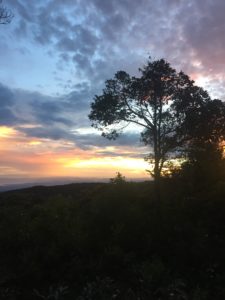 caution, I clicked open the new email. I winced, preparing for the possibility that I would once again find myself rejected from an internship opportunity. After all, it was only three months ago had I disbelievingly traced over each word of a similarly titled message; one that announced my rejection from an internship opportunity in Malaysia.
caution, I clicked open the new email. I winced, preparing for the possibility that I would once again find myself rejected from an internship opportunity. After all, it was only three months ago had I disbelievingly traced over each word of a similarly titled message; one that announced my rejection from an internship opportunity in Malaysia.
That rejection email came days before Lehigh University’s spring semester commenced, and rests on a page of my life’s story that I’ve dog-eared, retrospectively. I had banked on interning in Malaysia thanks to application essays and interviews in which I felt supremely confident. The offer to work abroad would have easily offset many of the anxieties amassed from the previous semester, my worst collegiate semester to date. But, struggles to pick a major and poor grades be damned. I was going to Malaysia, I insisted.
Wrong. The cold, sobering rejection email arrived in January. It did not change, no matter how many times I refreshed my inbox or re-read the message. I had, for all intents and purposes, reached the lowest point of my collegiate experience at that point. To make matters worse, I stood less than two weeks from a semester loaded with 20 credits and an eager helping of extracurricular responsibility. When others could then look toward a summer of international nirvana and self-discovery, I had nothing.
I had to change that. I pored through every summer job posting–domestic and international–that I could find. None seemed right, but I applied anyways. Desperately searching to no avail, I began to resign myself to another summer of working at home once more.
It was my mother who first directed me to Costa Rica, as her screenshot of the job snippet seized my interest from the moment it hit my phone. Learning more about the Children’s Eternal Rainforest only confirmed that interest. Their mission was profound, and their impact was doubly so. To work with the Children’s Eternal Rainforest would not only align with my recently-declared course of undergraduate study (Science and Environmental Writing), but it would lend a legitimate chance to fight the global climate crisis as well. I applied immediately.
Agonizing weeks passed. I pestered the program’s director with several emails and visits in the interim, anticipating the decision with the patience of a hungry toddler. Then, in the twilight hours of that Wednesday, March 20th, the email came.
“You have been accepted to the summer internship program in Costa Rica,” it read. I burst into laughter with joy.
It’s now been three months and 14 days since then (as of July 4th). In that time, I’ve rediscovered academic success, tacked on some long-term career goals, and said goodbye to the 30-minute proximity in which I’ve lived for 20 years for the verdant, green mountains of Monteverde, Costa Rica. Here, I now feel at-home working in the Bosque Eterno de los Niños, as I now know it. I’ve heard the metallic clank of the bell-bird, stared straight through the crystal wings of the glasswing butterfly, and while I have yet to see a sloth, I’m sure I won’t have to run after it if I spot one.
I’m extremely grateful for the privilege of working with Director Lindsay Stallcup and her dedicated crew that keeps intact 23,000 hectares of untouched land for five percent of the world’s birds, three percent of the world’s butterflies, and one lucky college student who gets to stay and hang with them for a bit.
It’s gonna be a fun few weeks here.
~ ~ ~ ~ ~ ~ ~ ~ ~ ~

Will Newbegin is a student at Lehigh Univeristy and is completing an internship with the Monteverde Conservation League from June to August 2019. This is the second in a series of guest blogs written by our interns. Edited by Lindsay Stallcup.
The post Stepping Out appeared first on ACMCR.
]]>Deprecated: Creation of dynamic property WP_Term::$cat_ID is deprecated in /home2/acmhosting/public_html/content/wp-includes/category.php on line 378
Deprecated: Creation of dynamic property WP_Term::$category_count is deprecated in /home2/acmhosting/public_html/content/wp-includes/category.php on line 379
Deprecated: Creation of dynamic property WP_Term::$category_description is deprecated in /home2/acmhosting/public_html/content/wp-includes/category.php on line 380
Deprecated: Creation of dynamic property WP_Term::$cat_name is deprecated in /home2/acmhosting/public_html/content/wp-includes/category.php on line 381
Deprecated: Creation of dynamic property WP_Term::$category_nicename is deprecated in /home2/acmhosting/public_html/content/wp-includes/category.php on line 382
Deprecated: Creation of dynamic property WP_Term::$category_parent is deprecated in /home2/acmhosting/public_html/content/wp-includes/category.php on line 383
The post Summer internships in the BEN! appeared first on ACMCR.
]]>~ ~ ~ ~ ~ ~ ~ ~ ~ ~ ~
My name is Nijayah Michél, one of two interns currently working with the Monteverde Conservation League. I am here in Costa Rica to help out the Children’s Eternal Rainforest, spread awareness, and learn firsthand about its mission and why it was founded. I hope I can use this trip to further my knowledge of nature and wildlife. I am a Sociology major, Spanish and Latin American Studies double minor at Lehigh University in Pennsylvania, USA. I am originally from New Jersey. We are starting our second week here at the Children’s Eternal Rainforest (also known as the BEN after the Spanish name, Bosque Eterno de los Niños). I am very excited to be interning with the BEN and learning about the organization as a whole and what ways we can spread awareness while we are here.
The first week was pretty calm. We arrived in Monteverde and met up with our host families. I am really enjoying staying with a host family, and they are very sweet and caring. I am glad I am able to do a homestay because it is a great way to improve my Spanish and learn firsthand about the Costa Rican culture.
 During the first week, we took a day and night hike along the trails in the Bajo del Tigre Reserve, part of the BEN. It was very interesting to experience the trails both times because we were able to take in the different aspects of the forest each time. During the day hike, most of the wildlife we saw were birds, including Three-wattled Bellbirds, which was a fascinating bird to learn about along the hike. I learned that the male and female bellbirds differ in their appearances. The male bellbirds are usually brown and white with long black whisker-like appendages, called wattles, hanging from their faces. The females, on the other hand, are a mix of green and yellow and do not have wattles. Females are usually smaller in size as compared to their male counterparts. I also found out that the juvenile male bellbirds resemble the adult females. The male bellbird’s call ranges from different types of bell sounds. I’ve heard “BONK” and “BRENK” from the different bellbirds while we were in Bajo del Tigre and also while traveling to the nearby town of Santa Elena.
During the first week, we took a day and night hike along the trails in the Bajo del Tigre Reserve, part of the BEN. It was very interesting to experience the trails both times because we were able to take in the different aspects of the forest each time. During the day hike, most of the wildlife we saw were birds, including Three-wattled Bellbirds, which was a fascinating bird to learn about along the hike. I learned that the male and female bellbirds differ in their appearances. The male bellbirds are usually brown and white with long black whisker-like appendages, called wattles, hanging from their faces. The females, on the other hand, are a mix of green and yellow and do not have wattles. Females are usually smaller in size as compared to their male counterparts. I also found out that the juvenile male bellbirds resemble the adult females. The male bellbird’s call ranges from different types of bell sounds. I’ve heard “BONK” and “BRENK” from the different bellbirds while we were in Bajo del Tigre and also while traveling to the nearby town of Santa Elena.
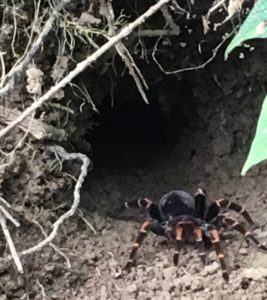 We also got to see a tarantula in its hole. I’m not a big fan of spiders in general, but it was cool to see the tarantula in its natural habitat. However, I was not willing to get that close! I stayed back far enough to see the tarantula at a safe distance. The night hike was off to a good start, but it was not as long as the day hike. I love being out in the nighttime so it was a great experience. I was able to hear everything, ranging from the rustling of the leaves or the sounds of the animals inhabiting Bajo del Tigre. I feel I am getting more familiar with the trails now as I continue to immerse myself in the forest. We also helped out with volunteer groups from Led2Serve. I was able to meet many cool, new people from Orlando, Florida (USA), and we were able to connect and share our own experiences we had with Costa Rica so far.
We also got to see a tarantula in its hole. I’m not a big fan of spiders in general, but it was cool to see the tarantula in its natural habitat. However, I was not willing to get that close! I stayed back far enough to see the tarantula at a safe distance. The night hike was off to a good start, but it was not as long as the day hike. I love being out in the nighttime so it was a great experience. I was able to hear everything, ranging from the rustling of the leaves or the sounds of the animals inhabiting Bajo del Tigre. I feel I am getting more familiar with the trails now as I continue to immerse myself in the forest. We also helped out with volunteer groups from Led2Serve. I was able to meet many cool, new people from Orlando, Florida (USA), and we were able to connect and share our own experiences we had with Costa Rica so far.
On the topic of Santa Elena (the main town in Monteverde), the town is delightful. It is a big difference from a big city, which I am more accustomed to. I am glad I am able to experience a different lifestyle than I am used to, because I feel that is the best way to be culturally informed. This trip is off to a fantastic start and I cannot wait for what else we may learn and experience.
~ ~ ~ ~ ~ ~ ~ ~ ~ ~ ~

Nijayah Michél is a student at Lehigh University (USA) and is completing an internship with the Monteverde Conservation League and Children’s Eternal Rainforest from June to August 2019. This is the first in a series of guest blogs written by our Lehigh interns. Edited by Lindsay Stallcup.
The post Summer internships in the BEN! appeared first on ACMCR.
]]>Deprecated: Creation of dynamic property WP_Term::$cat_ID is deprecated in /home2/acmhosting/public_html/content/wp-includes/category.php on line 378
Deprecated: Creation of dynamic property WP_Term::$category_count is deprecated in /home2/acmhosting/public_html/content/wp-includes/category.php on line 379
Deprecated: Creation of dynamic property WP_Term::$category_description is deprecated in /home2/acmhosting/public_html/content/wp-includes/category.php on line 380
Deprecated: Creation of dynamic property WP_Term::$cat_name is deprecated in /home2/acmhosting/public_html/content/wp-includes/category.php on line 381
Deprecated: Creation of dynamic property WP_Term::$category_nicename is deprecated in /home2/acmhosting/public_html/content/wp-includes/category.php on line 382
Deprecated: Creation of dynamic property WP_Term::$category_parent is deprecated in /home2/acmhosting/public_html/content/wp-includes/category.php on line 383
The post Saving water in the rainforest appeared first on ACMCR.
]]>
Walking along the trails near San Gerardo field station in the Children’s Eternal Rainforest, the forest puts on symphony of rustling leaves, singing birds, and humming insects, with frogs and the occasional monkey joining the chorus. Beneath all these sounds, I hear the steady drumming of water flowing over the landscape in rivers or sometimes falling from the clouds as raindrops showering down through the canopy. Even when it wasn’t raining, by the time I had finished my hiking through the forest, I was damp from moving through the steady mist hanging in the air.
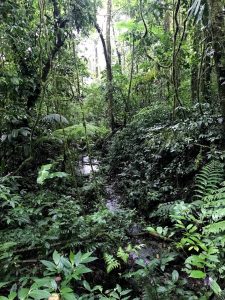 Water is an integral part of the rainforest and a key ingredient for the life that flourishes here. After all, what would a rainforest be without the rain? The forest acts as a sponge for all of this precipitation, the dense vegetation soaking up water from the air. What isn’t absorbed by the plants and soil collects and flows down streams and rivers, into larger bodies of water like rivers, Lake Arenal, and eventually the ocean. Along the way, thousands of people rely on this water to drink, for agricultural production, and to provide power from hydroelectric plants. Just within the 22,600 hectares of the Children’s Eternal Rainforest, the headwaters (=source) of five watersheds are protected. This means that the water in the Arenal, Peñas Blancas, San Carlos, Guacimal and Aranjauez watersheds originates in the CER, where it is captured by and filtered through the forest and protected from pollution.
Water is an integral part of the rainforest and a key ingredient for the life that flourishes here. After all, what would a rainforest be without the rain? The forest acts as a sponge for all of this precipitation, the dense vegetation soaking up water from the air. What isn’t absorbed by the plants and soil collects and flows down streams and rivers, into larger bodies of water like rivers, Lake Arenal, and eventually the ocean. Along the way, thousands of people rely on this water to drink, for agricultural production, and to provide power from hydroelectric plants. Just within the 22,600 hectares of the Children’s Eternal Rainforest, the headwaters (=source) of five watersheds are protected. This means that the water in the Arenal, Peñas Blancas, San Carlos, Guacimal and Aranjauez watersheds originates in the CER, where it is captured by and filtered through the forest and protected from pollution.
Watershed protection is among the most important ecosystem services provided by the rainforest. In fact, watershed protection is so vital that the beginnings of conservation in the Monteverde area can be traced back to the goal of maintaining a clean water supply. When a group of Quakers settled in Monteverde in 1951, one of the first things they did was set aside 553 hectares (1366 acres) of forest to ensure a reliable and clean water source. The establishment of this “watershed reserve” sowed the seeds for the conservation ethos that has become a cornerstone of Monteverde’s identity, although it was done for very practical purposes at first. The Quakers realized that without clean, potable water, their community would not be able to survive. The same is true for communities today, and the Children’s Eternal Rainforest and surrounding protected areas act as a protective buffer for the five watersheds that stem from it, just as that original protected area established by the Quakers did for their settlement.
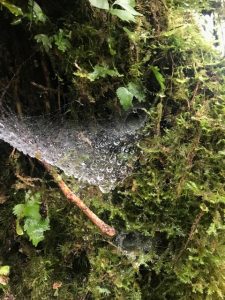 It can be difficult to understand why the rainforest is so important for water conservation. After all, it seems the rain would still fall and rivers would still flow, even if the forest were cut down. However, without the roots of the rainforest to hold the soil in place, rainfall would quickly wash away all of the soil and nutrients that are held within it, making for very poor quality land for farming and a pretty barren landscape. Landslides would be more common, and the eroded soil would contaminate rivers downstream.
It can be difficult to understand why the rainforest is so important for water conservation. After all, it seems the rain would still fall and rivers would still flow, even if the forest were cut down. However, without the roots of the rainforest to hold the soil in place, rainfall would quickly wash away all of the soil and nutrients that are held within it, making for very poor quality land for farming and a pretty barren landscape. Landslides would be more common, and the eroded soil would contaminate rivers downstream.
Additionally, much of the water that the rainforest harnesses is not actually from rain as it is traditionally understood. While it is true that a large amount of the precipitation does come from vertical rainfall, water from horizontal precipitation in the form of mist, clouds and fog contributes as much as 70% of the precipitation in Monteverde during some parts of the drier season. Without the rainforest, horizontal precipitation would be carried in the wind and never make it into the water supply. However, when the clouds and mist hit the forest, the water is collected by the plants and adds a significant amount to the supply that ends up in the surrounding watersheds and eventually might flow through someone’s faucet, onto farmland, or through a hydroelectric turbine to create electricity.
Not only is water a source of life, but also a source of power. Flowing water is a powerful force that can be used to create electricity through hydropower plants. The source waters protected within the CER flow into streams and rivers along which hydroelectric plants have been built to supply energy to homes and businesses throughout Costa Rica. Around 60-70% of Costa Rica’s energy comes from hydroelectric plants, which are a clean alternative to fossil fuels. The Arenal watershed, which is one of the five whose headwaters are protected within the CER, contributes an estimated 20-30% of Costa Rica’s hydroelectricity. This same watershed provides vital irrigation to the Guanacaste province.
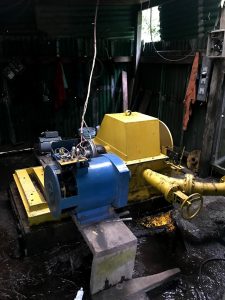 The San Gerardo field station in the Children’s Eternal Rainforest also utilizes the power of water to generate electricity for the station. The hydroelectric plant that powers San Gerardo is nothing particularly fancy; in fact, when I saw it, I was surprised at how simple the technology really was. A series of pipes feed water through a tank to filter out debris. The water then flows into a series of smaller pipes, and onto a wheel with little cups. When the water fills the cups, it causes the wheel to spin. This spinning wheel, known as a pelton wheel, connects to an old industrial motor that has been repurposed to produce an electrical current. Thus, moving water is transformed into electricity, which is sent to the station to provide power for lights and basic electrodomestic appliances. The clean water flows back into the river, completing the clean energy loop.
The San Gerardo field station in the Children’s Eternal Rainforest also utilizes the power of water to generate electricity for the station. The hydroelectric plant that powers San Gerardo is nothing particularly fancy; in fact, when I saw it, I was surprised at how simple the technology really was. A series of pipes feed water through a tank to filter out debris. The water then flows into a series of smaller pipes, and onto a wheel with little cups. When the water fills the cups, it causes the wheel to spin. This spinning wheel, known as a pelton wheel, connects to an old industrial motor that has been repurposed to produce an electrical current. Thus, moving water is transformed into electricity, which is sent to the station to provide power for lights and basic electrodomestic appliances. The clean water flows back into the river, completing the clean energy loop.
When we think of rainforest conservation, we tend to think of saving the jaguars and protecting tree frogs, but protecting water for hydropower, agriculture, and drinking doesn’t always come to mind. However, without the ecosystem services of water purification and protection, and the sponge-like ability of the rainforest to capture water, these resources would be in jeopardy. While protecting the rainforest certainly benefits the wildlife that lives within it, humans need rainforest protection just as much, even if in less obvious ways like keeping the watersheds we rely on functioning smoothly.
Elizabeth Gagliardi successfully completed an internship with the Monteverde Conservation League and Children’s Eternal Rainforest from June to August 2018. She is a student at Lehigh University. Edited by Lindsay Stallcup.
The post Saving water in the rainforest appeared first on ACMCR.
]]>Deprecated: Creation of dynamic property WP_Term::$cat_ID is deprecated in /home2/acmhosting/public_html/content/wp-includes/category.php on line 378
Deprecated: Creation of dynamic property WP_Term::$category_count is deprecated in /home2/acmhosting/public_html/content/wp-includes/category.php on line 379
Deprecated: Creation of dynamic property WP_Term::$category_description is deprecated in /home2/acmhosting/public_html/content/wp-includes/category.php on line 380
Deprecated: Creation of dynamic property WP_Term::$cat_name is deprecated in /home2/acmhosting/public_html/content/wp-includes/category.php on line 381
Deprecated: Creation of dynamic property WP_Term::$category_nicename is deprecated in /home2/acmhosting/public_html/content/wp-includes/category.php on line 382
Deprecated: Creation of dynamic property WP_Term::$category_parent is deprecated in /home2/acmhosting/public_html/content/wp-includes/category.php on line 383
The post Research in the BEN appeared first on ACMCR.
]]>
El Bosque Eterno de los Niños (BEN) is the ideal setting for any student or professional interested in conducting research in one of the world’s most biodiverse regions. Covering 7 of Costa Rica’s 12 life zones (different habitat types), the BEN is home to a wide variety of flora and fauna. Some species area endangered and others endemic to the region.
In addition to being the perfect natural laboratory, the BEN has two rainforest field stations, San Gerardo and Pocosol, that offer lodging and three meals per day. Special rates are given to approved research projects, and all proceeds go directly towards conservation!
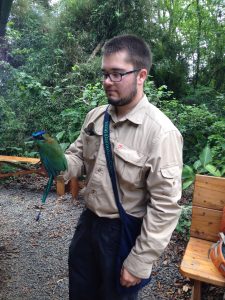 During my stay in the BEN, a research project was being carried out by Kyle Davis (pictured at right with a Lesson’s Motmot), a rising senior from Ohio Wesleyan University. Kyle, a microbiology and zoology major, is a member of numerous scientific associations and conservation societies. His main interest is studying microbiomes on birds — specifically, how some bacteria use birds as their host.
During my stay in the BEN, a research project was being carried out by Kyle Davis (pictured at right with a Lesson’s Motmot), a rising senior from Ohio Wesleyan University. Kyle, a microbiology and zoology major, is a member of numerous scientific associations and conservation societies. His main interest is studying microbiomes on birds — specifically, how some bacteria use birds as their host.
In his research project, “Feather-degrading Bacteria in a Tropical Environment”, Kyle focuses on a type of bacteria that lives on birds and causes their feathers to decompose. While this may sound harmful to the bird, in some cases the bacteria actually benefits its host. Some bird species, such as the blue jay in the U.S., get their bright blue color from the way their feathers are layered. When the feather-decomposing bacteria is present on a blue jay, it actually is decomposing a layer of keratin on specific feathers, thus making the blue coloration of the bird more vibrant, and (in the case of a male blue jay), potentially making the bird more desirable for mates.
Some research on feather-decomposing bacteria has been done in the U.S. and Australia, but they are yet to be studied in Costa Rica. Kyle’s work will reveal if the bacteria are present, to what extent, and provide more insight into how this complex microbiome operates. Also, if the bacteria are discovered, Kyle will be comparing the rates that this bacteria decomposes feathers as compared to the other feather-decomposing bacteria present in the U.S. and Australia. Kyle predicts that this bacteria will be present, more efficient, and, if so, this discovery will hold rather large implications for the human world as well.
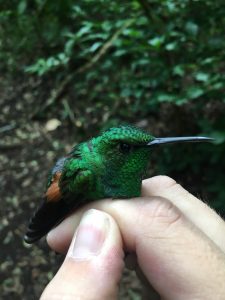 As I learned from Kyle, many poultry businesses face the obstacle of what to do with the waste feathers once all of the birds (chickens, turkeys, or otherwise) have been plucked. Currently, most businesses in the industry bury the feathers (because they are chemically very stable and take a long time to decompose) or burn them. Both of these practices have negative environmental impacts; if an efficient feather-decomposing bacteria is discovered, it could provide a natural alternative for disposing of the feathers.
As I learned from Kyle, many poultry businesses face the obstacle of what to do with the waste feathers once all of the birds (chickens, turkeys, or otherwise) have been plucked. Currently, most businesses in the industry bury the feathers (because they are chemically very stable and take a long time to decompose) or burn them. Both of these practices have negative environmental impacts; if an efficient feather-decomposing bacteria is discovered, it could provide a natural alternative for disposing of the feathers.
Kyle is grateful to the staff of BEN, who he says are extremely friendly, knowledgeable, and have facilitated the success of his project. He recommends anyone interested in doing research in Costa Rica to look into conducting their project at the BEN. “Not only did BEN provide a quick response time when I submitted my proposal,” says Kyle, “but they have also been very user-friendly during my time here.”
Are you a student or professional interested in conducting research at the BEN? If so, contact Lindsay Stallcup, or refer to the BEN’s website for research proposal forms.
Angie Rizzo successfully completed an internship with the Monteverde Conservation League and Children’s Eternal Rainforest from June to August 2018. She is a student at Lehigh University. Edited by Lindsay Stallcup.
The post Research in the BEN appeared first on ACMCR.
]]>Deprecated: Creation of dynamic property WP_Term::$cat_ID is deprecated in /home2/acmhosting/public_html/content/wp-includes/category.php on line 378
Deprecated: Creation of dynamic property WP_Term::$category_count is deprecated in /home2/acmhosting/public_html/content/wp-includes/category.php on line 379
Deprecated: Creation of dynamic property WP_Term::$category_description is deprecated in /home2/acmhosting/public_html/content/wp-includes/category.php on line 380
Deprecated: Creation of dynamic property WP_Term::$cat_name is deprecated in /home2/acmhosting/public_html/content/wp-includes/category.php on line 381
Deprecated: Creation of dynamic property WP_Term::$category_nicename is deprecated in /home2/acmhosting/public_html/content/wp-includes/category.php on line 382
Deprecated: Creation of dynamic property WP_Term::$category_parent is deprecated in /home2/acmhosting/public_html/content/wp-includes/category.php on line 383
The post The Nightlife of the Rainforest appeared first on ACMCR.
]]>In Costa Rica it gets dark pretty early, almost always before 6:30 PM. I often found myself getting tired as the sun set and the day’s multiple cups of coffee wore off, feeling ready to head to bed as early as 7:00 some nights. While I was getting ready to go to sleep, though, the rainforest was still very much awake. A few times, I stayed up and ventured into the forest on a night hike to experience the nightlife for myself. The handful of guided night hikes I went on were some of my favorite experiences of my time in Costa Rica. The guides I was lucky enough to hike with in the BEN left me in awe of their knowledge of the forest and ability to uncover secret wonders that my untrained eye would never have spotted. In the Children’s Eternal Rainforest (“BEN”), anything you see on a hike is there naturally, since they never manipulate or feed the animals for visitors. That being said, it’s better not to start a hike with expectations of seeing a specific animal, but in a place as biodiverse as the BEN, you’re bound to see something exciting. Plus, the mystery of not knowing what lies ahead makes any sighting all the more special.
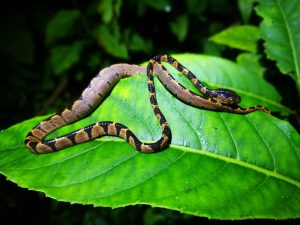 Being in the rainforest at any time of day is an amazing experience, but there’s something extra special about going in at night. On a night hike you’ll have a flashlight, but not relying completely on the sense of sight changes the experience. On one night hike near the San Gerardo field station, our guide stopped and asked everyone to turn off the flashlights just to listen and try to count how many layers of sound we could identify. I lost count around 10. The chorus of different frogs, crickets and birds meshed with falling rain, rustling leaves and the trickling of a stream flowing nearby. The whole thing sounded like one of those nature soundtracks you might hear in a yoga class or put on to help you fall asleep, but more vibrant and so alive. While it’s true that the rainforest is filled with vibrant colors and spectacular sights, the symphony of surrounding sounds can be just as breathtaking when you tune in.
Being in the rainforest at any time of day is an amazing experience, but there’s something extra special about going in at night. On a night hike you’ll have a flashlight, but not relying completely on the sense of sight changes the experience. On one night hike near the San Gerardo field station, our guide stopped and asked everyone to turn off the flashlights just to listen and try to count how many layers of sound we could identify. I lost count around 10. The chorus of different frogs, crickets and birds meshed with falling rain, rustling leaves and the trickling of a stream flowing nearby. The whole thing sounded like one of those nature soundtracks you might hear in a yoga class or put on to help you fall asleep, but more vibrant and so alive. While it’s true that the rainforest is filled with vibrant colors and spectacular sights, the symphony of surrounding sounds can be just as breathtaking when you tune in.
Despite the limited visibility, if you know where to look there’s actually quite a lot to see in the forest at night as well. Personally, trying to find tiny frogs, snakes and other critters in the dark jungle seemed near impossible at first, but night hikes are at a slower pace, allowing time to look around, and after following the guides into the forest, things begin to reveal themselves. The guides that lead night hikes in the BEN are like walking encyclopedias of forest knowledge. They seem to know the place like the back of their hand, and not only do they know frogs’ favorite spots, what kind of spider wove the impressive web on that tree, and where to look for bio-luminescence, but they also take time to explain interesting plant species you may pass by and how every little detail of the forest is interconnected. Every hike I took I learned something new, and I left each with a deeper 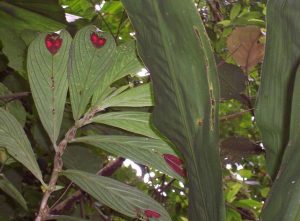 appreciation for all of the life within the forest. Even the plant life, which at first glance can just seem like a mass of green, is incredibly diverse and full of surprises, like the Sangre de Cristo (Blood of Christ) plant. This plant looks pretty much like all the other green leafy vegetation growing around, but when you look underneath, there are red markings on the underside of its leaves. Not only is this plant beautiful, our guide explained, but the red markings are a survival tool as well. The plant grows at the top of the canopy, and it relies on hummingbirds to pollinate its flowers. Unfortunately for this plant, hummingbirds rarely fly to the top of the canopy. However, they are attracted to the color red, and so the Sangre de Cristo plant evolved to have the red spots on the underside of its leaves where hummingbirds below will spot a flash of red, fly up, and feed on its nectar, pollinating the flower.
appreciation for all of the life within the forest. Even the plant life, which at first glance can just seem like a mass of green, is incredibly diverse and full of surprises, like the Sangre de Cristo (Blood of Christ) plant. This plant looks pretty much like all the other green leafy vegetation growing around, but when you look underneath, there are red markings on the underside of its leaves. Not only is this plant beautiful, our guide explained, but the red markings are a survival tool as well. The plant grows at the top of the canopy, and it relies on hummingbirds to pollinate its flowers. Unfortunately for this plant, hummingbirds rarely fly to the top of the canopy. However, they are attracted to the color red, and so the Sangre de Cristo plant evolved to have the red spots on the underside of its leaves where hummingbirds below will spot a flash of red, fly up, and feed on its nectar, pollinating the flower.
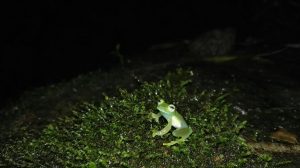 While learning about new plants is fascinating, for most people the highlight of a night hike is getting to see the animals species that come out at night. Since BEN doesn’t feed or manipulate animals, what you will see on any given night hike is a total surprise. In my opinion, this element of surprise adds to the fun of the night hike experience, plus this also means that whatever you do see is the real deal. It doesn’t get more authentic than that. On one night hike in Bajo del Tigre, we saw a mot mot on a branch with its head tucked under a wing, fast asleep, as well as countless cool insects (including a ton of walking and flying stick insects), some beautiful moths, a frog, a tarantula, and my favorite of the night – a scorpion. Eduardo, our guide, explained that there are many species of scorpions in the world and many of the ones found in Costa Rica are actually pretty harmless. Their sting will hurt, but won’t kill you (much like getting a bee sting). Just when I thought it couldn’t get much cooler, our guide pulled out a blacklight and held it over the scorpion which glowed under the UV. Why scorpions glow under UV light is not well understood, but it sure was impressive. On another night hike near San Gerardo, our guide picked up some sticks from beside the trail. At first I wondered why we had stopped for a couple of sticks, but he then asked us all to turn off our flashlights and the sticks glowed in the dark! To me, it seemed like magic but of course there is a scientific explanation – bio-luminescent fungus. Even the smallest details in the rainforest are full of incredible surprises.
While learning about new plants is fascinating, for most people the highlight of a night hike is getting to see the animals species that come out at night. Since BEN doesn’t feed or manipulate animals, what you will see on any given night hike is a total surprise. In my opinion, this element of surprise adds to the fun of the night hike experience, plus this also means that whatever you do see is the real deal. It doesn’t get more authentic than that. On one night hike in Bajo del Tigre, we saw a mot mot on a branch with its head tucked under a wing, fast asleep, as well as countless cool insects (including a ton of walking and flying stick insects), some beautiful moths, a frog, a tarantula, and my favorite of the night – a scorpion. Eduardo, our guide, explained that there are many species of scorpions in the world and many of the ones found in Costa Rica are actually pretty harmless. Their sting will hurt, but won’t kill you (much like getting a bee sting). Just when I thought it couldn’t get much cooler, our guide pulled out a blacklight and held it over the scorpion which glowed under the UV. Why scorpions glow under UV light is not well understood, but it sure was impressive. On another night hike near San Gerardo, our guide picked up some sticks from beside the trail. At first I wondered why we had stopped for a couple of sticks, but he then asked us all to turn off our flashlights and the sticks glowed in the dark! To me, it seemed like magic but of course there is a scientific explanation – bio-luminescent fungus. Even the smallest details in the rainforest are full of incredible surprises.
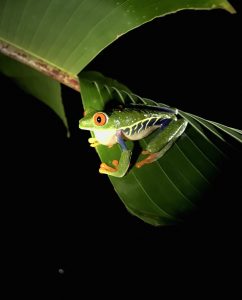 On that same hike in San Gerardo, we spotted a palm striped pit viper hanging out on a tree branch, a glass frog, and a rufous-eyed rain frog. Many frogs are nocturnal, making them a fan favorite on night hikes. On one night in Pocosol we found eleven different species! I’m certainly no frog expert, but I would bet that I managed to see more different types of frogs in one weekend at Pocosol than I’d seen in my life. While all of the species we saw were exciting in their own right, my favorite by far was the red eyed tree frog. We spotted this breathtaking frog on a bush at the beginning of our night hike, and although I’d seen photos of this species before I was stunned by how bright and beautiful it’s colors were in real life. While there’s no guarantee of seeing a red eyed tree frog or any other species on any given night hike, the possibility alone is well worth going. Every night hike I’ve taken in the BEN has been a unique and magical experience, full of surprises and some truly spectacular species.
On that same hike in San Gerardo, we spotted a palm striped pit viper hanging out on a tree branch, a glass frog, and a rufous-eyed rain frog. Many frogs are nocturnal, making them a fan favorite on night hikes. On one night in Pocosol we found eleven different species! I’m certainly no frog expert, but I would bet that I managed to see more different types of frogs in one weekend at Pocosol than I’d seen in my life. While all of the species we saw were exciting in their own right, my favorite by far was the red eyed tree frog. We spotted this breathtaking frog on a bush at the beginning of our night hike, and although I’d seen photos of this species before I was stunned by how bright and beautiful it’s colors were in real life. While there’s no guarantee of seeing a red eyed tree frog or any other species on any given night hike, the possibility alone is well worth going. Every night hike I’ve taken in the BEN has been a unique and magical experience, full of surprises and some truly spectacular species.
If you’ll be visiting the Monteverde area, make sure you find an evening to experience the rainforest after dark! Check out the BEN website here for rates and to make a reservation for a night hike in Bajo del Tigre or to stay at a field station in San Gerardo or Pocosol.
Elizabeth Gagliardi successfully completed an internship with the Monteverde Conservation League and Children’s Eternal Rainforest from June to August 2018. She is a student at Lehigh University.
The post The Nightlife of the Rainforest appeared first on ACMCR.
]]>Deprecated: Creation of dynamic property WP_Term::$cat_ID is deprecated in /home2/acmhosting/public_html/content/wp-includes/category.php on line 378
Deprecated: Creation of dynamic property WP_Term::$category_count is deprecated in /home2/acmhosting/public_html/content/wp-includes/category.php on line 379
Deprecated: Creation of dynamic property WP_Term::$category_description is deprecated in /home2/acmhosting/public_html/content/wp-includes/category.php on line 380
Deprecated: Creation of dynamic property WP_Term::$cat_name is deprecated in /home2/acmhosting/public_html/content/wp-includes/category.php on line 381
Deprecated: Creation of dynamic property WP_Term::$category_nicename is deprecated in /home2/acmhosting/public_html/content/wp-includes/category.php on line 382
Deprecated: Creation of dynamic property WP_Term::$category_parent is deprecated in /home2/acmhosting/public_html/content/wp-includes/category.php on line 383
The post Every Day is Earth Day with Environmental Education appeared first on ACMCR.
]]>In many ways, Costa Rica is incredibly progressive in terms of environmental protection and conservation. The country has developed somewhat of a “green” reputation with its strict no hunting laws, biological corridors, and large ecotourist economy centered around national parks and private reserves. At one point, Costa Rica actually had the fastest deforestation rate in all of Latin America, buf after realizing the impacts of losing nearly 70% of the nation’s forest cover in less than 40 years, steps were taken to halt deforestation and bring back some of what had been lost. Forest cover has been increasing in Costa Rica since the late 1980s when it reached its lowest point, thanks to a variety of laws and practices including establishment of “Zonas Protectoras”, or protected zones where land use is more heavily regulated, as well as the extensive system of national parks and private reserves like the Children’s Eternal Rainforest (or “BEN”, after the Spanish “Bosque Eterno de los Niños”). Of course, there is always more work to be done on this front, but one of the best ways to further environmental protection and amplify change is through education.
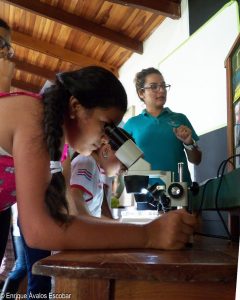 The Monteverde Conservation League is the Costa Rican nonprofit organization that owns and protects the BEN. The MCL has been instrumental in creating a community that understands, embraces and contributes to the positive impacts of conserving the forest in their backyard. Monteverde has a long history of environmental conservation, beginning in large part with the arrival of Quaker settlers in the 1950s who set aside 550 hectares of land to protect vital water resources. The mindset of conservation in Monteverde has only grown since, with three large private reserves (BEN, The Monteverde Cloud Forest, and the Santa Elena Reserve) bordering the community. Not only does conservation help protect soil and water, benefit biodiversity, and contribute to the health of ecosystems, but the reserves also attract lots of visitors and help sustain the local economy. After spending time in Monteverde on the Pacific side of the BEN and getting to know the people here, it is clear that the community really does embrace and appreciate the forest and are on board with keeping it protected for generations to come. However, on the eastern border (Caribbean slope) of the BEN, the conservation mindset has been slower to develop. Luckily, when purchasing land for protection, the Monteverde Conservation League prioritized buying land in the Penas Blancas Valley, halting a great deal of deforestation for agriculture and land development in the area. Now, a big focus of keeping this protected land “eternal” has shifted to providing environmental education in the surrounding communities.
The Monteverde Conservation League is the Costa Rican nonprofit organization that owns and protects the BEN. The MCL has been instrumental in creating a community that understands, embraces and contributes to the positive impacts of conserving the forest in their backyard. Monteverde has a long history of environmental conservation, beginning in large part with the arrival of Quaker settlers in the 1950s who set aside 550 hectares of land to protect vital water resources. The mindset of conservation in Monteverde has only grown since, with three large private reserves (BEN, The Monteverde Cloud Forest, and the Santa Elena Reserve) bordering the community. Not only does conservation help protect soil and water, benefit biodiversity, and contribute to the health of ecosystems, but the reserves also attract lots of visitors and help sustain the local economy. After spending time in Monteverde on the Pacific side of the BEN and getting to know the people here, it is clear that the community really does embrace and appreciate the forest and are on board with keeping it protected for generations to come. However, on the eastern border (Caribbean slope) of the BEN, the conservation mindset has been slower to develop. Luckily, when purchasing land for protection, the Monteverde Conservation League prioritized buying land in the Penas Blancas Valley, halting a great deal of deforestation for agriculture and land development in the area. Now, a big focus of keeping this protected land “eternal” has shifted to providing environmental education in the surrounding communities.
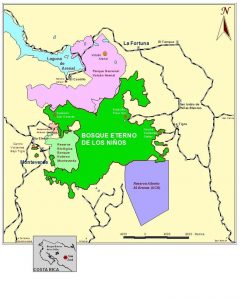
While I spent most of my two month internship with BEN on the Pacific Slope and in Monteverde, I had the chance to visit Pocosol Station and the Finca Steller environmental education center on the Caribbean side. Here I met BEN’s full time environmental educator, Maria Fernanda Rojas, who works with with kids in grades K-6 at 17 public schools on the Caribbean side of the BEN . The schools range in size from larger classes to very small schools with only one teacher (called unidocentes), so having Maria Fernanda’s help and expertise to incorporate environmental education into the curriculum is invaluable for these students. Her time is split between the many schools BEN works with, and she goes to each of the seventeen once per month to give classroom presentations and small workshops or investigations with the students.
The curriculum covers a range of topics and is centered around themes of conservation, stressing things like not to mistreat animals and ways to protect and respect the forest. Maria Fernanda also teaches students about water conservation, natural resources, climate change and more.
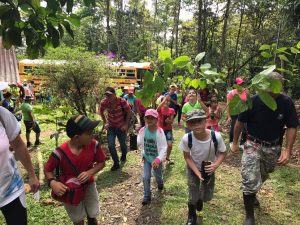 About once a year, BEN brings the students from each school to Finca Steller for hands-on activities. I had the awesome opportunity to tag along on one of these lessons with a class, and I could see right away how excited the students were when they arrived. Maria Fernanda clearly has a gift for teaching – many of the students greeted her with a hug, and they were all so enthusiastic about the hike. Before the lesson had even began I could already see that BEN’s environmental education program was a positive thing for these kids. The lesson began with a short hike, stopping at a stream to collect, identify, observe and answer some questions about aquatic insects. The kids had so much fun splashing around in the stream before we hiked back out and went into the classroom to look at microscope slides and talk about the connections between aquatic insects and water quality.
About once a year, BEN brings the students from each school to Finca Steller for hands-on activities. I had the awesome opportunity to tag along on one of these lessons with a class, and I could see right away how excited the students were when they arrived. Maria Fernanda clearly has a gift for teaching – many of the students greeted her with a hug, and they were all so enthusiastic about the hike. Before the lesson had even began I could already see that BEN’s environmental education program was a positive thing for these kids. The lesson began with a short hike, stopping at a stream to collect, identify, observe and answer some questions about aquatic insects. The kids had so much fun splashing around in the stream before we hiked back out and went into the classroom to look at microscope slides and talk about the connections between aquatic insects and water quality.
I asked Maria Fernanda about the impact these trips into the forest and environmental education has had on the surrounding community. She told me that among the older generations, many people were raised hunting, cutting trees, and clearing land and that these attitudes still persist among many older people. Hunting is illegal in Costa Rica, but it can be difficult to enforce and still goes on. However, since environmental education started coming into the area through BEN, attitudes are changing among younger generations. Perhaps years ago hunting was a means for survival, but nowadays it is just for sport. Many young people – including lots of the kids Maria Fernanda works with – understand the value of protecting species, and have no desire to hunt or clear forested land. In fact, many young people are beginning to get jobs in conservation and the ecotourism industry and are experiencing firsthand the benefits of protecting the forests.
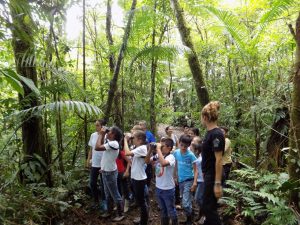
When I asked what the most rewarding part of her job is, Maria Fernanda first explained that though many of the kids she works with live right next to the forest, often they have never ventured into the magical world under the canopy. They stay away either because they are afraid, because their parents haven’t taken them, or some combination of both. It can be difficult to appreciate the forest without knowing what lies inside and understanding it. Many of the children’s first hike into the forest is for environmental education with the BEN. They’ll light up and exclaim “¡es el dia mas feliz de mi vida!”, which means “this is the happiest day of my life!”. To be able to take kids into the forest and teach them to appreciate and love the plants and animals they share a community with is an incredibly rewarding experience for Maria Fernanda, and is a testament to the importance of providing environmental education.
Elizabeth Gagliardi was an intern with the Monteverde Conservation League and Children’s Eternal Rainforest from June to August 2018. She is currently a student at Lehigh University, USA.
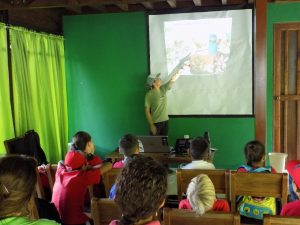
The post Every Day is Earth Day with Environmental Education appeared first on ACMCR.
]]>Deprecated: Creation of dynamic property WP_Term::$cat_ID is deprecated in /home2/acmhosting/public_html/content/wp-includes/category.php on line 378
Deprecated: Creation of dynamic property WP_Term::$category_count is deprecated in /home2/acmhosting/public_html/content/wp-includes/category.php on line 379
Deprecated: Creation of dynamic property WP_Term::$category_description is deprecated in /home2/acmhosting/public_html/content/wp-includes/category.php on line 380
Deprecated: Creation of dynamic property WP_Term::$cat_name is deprecated in /home2/acmhosting/public_html/content/wp-includes/category.php on line 381
Deprecated: Creation of dynamic property WP_Term::$category_nicename is deprecated in /home2/acmhosting/public_html/content/wp-includes/category.php on line 382
Deprecated: Creation of dynamic property WP_Term::$category_parent is deprecated in /home2/acmhosting/public_html/content/wp-includes/category.php on line 383
The post Lessons from the Leaf Cutters appeared first on ACMCR.
]]>Small but Mighty
Tropical forests are full of interesting creatures, but (speaking from my own perspective, anyway) ants don’t usually come to mind as a particularly exciting tropical species. When it comes to ants, we often think of an annoyance to keep out of kitchens and homes, and it’s often our first instinct to kill an ant when we see it — perhaps worried about its bite, or just to get rid of one more picnic pest. While some of the over 12,000 ant species worldwide may fit that description, most of them are really incredible when you get a closer look at their life. In fact, after learning a bit more about their complex and specialized lives, Costa Rica’s leaf cutter ants have quickly become one of my personal favorite species.
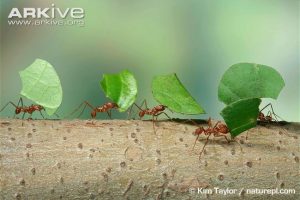
There are about fifty known species of leaf cutter ants, and they are found primarily in the Neotropical region of Central and South America. Walking around Monteverde, especially in the trails of the forest, but sometimes even beside the road or even right behind the BEN office (where I’m watching a colony work tirelessly as I write about them), you’ll likely see small well worn paths full of little ants marching along, many carrying green leaf cuttings many times their own size. These are the leaf cutters, hard at work. Seeing this spectacle, you might assume that the ants are cutting and carrying leaves for food. In a way, this is true, but the ants don’t actually eat the leaves they go to such great lengths to collect. Instead, they bring the leaf cuttings back to the colony where they are fed to a fungus that the ants then eat. Harvesting this fungus, fending off disease, and maintaining a healthy colony is no small task, and the complexity and intricacy of how these ants operate is incredible.
Girl Power and Teamwork
Leaf cutters really understand teamwork – they have to work together to keep their fungus farms healthy and their colony alive and well. No one ant can do all of the tasks necessary to achieve a successful colony, so each ant has a specific role. The queen establishes a new colony and starts the fungus garden, and then has the sole role of laying eggs. Male ants have wings and fly between colonies to help queens reproduce. The rest of the ants are all infertile females that serve as workers, soldiers and guards. In fact, none of the ants you see trekking on well worn paths with leaf cuttings many times their own body weight are males, all of them are hard working women!
Farmers and Pharmacists of the Forest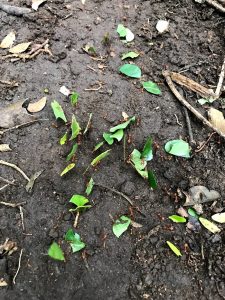
The ants and the fungus have evolved the perfect mutualistic relationship where each benefits the other. The fungus is given food and protection from disease by the ants, and the ants are provided with food from the fungus that they cultivate. The ants secrete chemicals to help the fungus they feed on to grow, and they also produce bacteria that kills off parasitic fungus and other threatening diseases. We’ve learned a lot from these ants too, and use this same bacterium in many of our own pharmaceutical antibiotic drugs.
The ants also divide their colonies into distinct areas to keep the fungus and the ants healthy. Part of the colony is the farm, where ants bring leaf cuttings, chew them up a bit and “feed” the fungus. Younger workers tend to the farm areas, and older workers move on to the another part of the colony that serves as a dump. Here older ants finish out their final days, dying away from the healthier parts of the colony and keeping waste and harmful parasites contained.
Part of the Bigger Picture
While leaf cutter colonies are incredible ecosystems in their own right, they are also a part of the larger forest ecosystem and they play a key role in this bigger picture. Though ants are small, leaf cutters have been described as “the dominant herbivores of the New World tropics” (Britannica). Their habit of 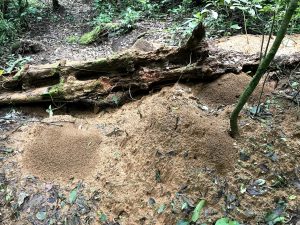 cutting leaves helps encourage plant growth, and their fungus farms enrich soil. Leaf cutter ants serve as a nice reminder that even seemingly small actions can lead to impressive results and teamwork can move mountains (and leaf piles). So next time you cross paths with an ant, think twice before squishing it – especially if it happens to be a leaf cutter!
cutting leaves helps encourage plant growth, and their fungus farms enrich soil. Leaf cutter ants serve as a nice reminder that even seemingly small actions can lead to impressive results and teamwork can move mountains (and leaf piles). So next time you cross paths with an ant, think twice before squishing it – especially if it happens to be a leaf cutter!
References:
“Leafcutter Ant.” Encyclopædia Britannica, Encyclopædia Britannica, Inc., 17 Apr. 2017, www.britannica.com/animal/leafcutter-ant.
Fendt, Lindsay. “The Secret Lives of Leaf-Cutting Ants.” The Tico Times, 3 Apr. 2015, www.ticotimes.net/2015/04/03/the-secret-lives-of-leaf-cutting-ants.
Simões-Gomes, Flávia Carolina, et al. “Geographical Distribution Patterns and Niche Modeling of the Iconic Leafcutter Ant Acromyrmex Striatus (Hymenoptera: Formicidae).” Journal of Insect Science, vol. 17, no. 2, 1 Mar. 2017, www.ncbi.nlm.nih.gov/pmc/articles/PMC5416825/.
Angie Rizzo successfully completed an internship with the MCL and Children’s Eternal Rainforest from June to August 2018. She is a student at Lehigh University.
The post Lessons from the Leaf Cutters appeared first on ACMCR.
]]>Deprecated: Creation of dynamic property WP_Term::$cat_ID is deprecated in /home2/acmhosting/public_html/content/wp-includes/category.php on line 378
Deprecated: Creation of dynamic property WP_Term::$category_count is deprecated in /home2/acmhosting/public_html/content/wp-includes/category.php on line 379
Deprecated: Creation of dynamic property WP_Term::$category_description is deprecated in /home2/acmhosting/public_html/content/wp-includes/category.php on line 380
Deprecated: Creation of dynamic property WP_Term::$cat_name is deprecated in /home2/acmhosting/public_html/content/wp-includes/category.php on line 381
Deprecated: Creation of dynamic property WP_Term::$category_nicename is deprecated in /home2/acmhosting/public_html/content/wp-includes/category.php on line 382
Deprecated: Creation of dynamic property WP_Term::$category_parent is deprecated in /home2/acmhosting/public_html/content/wp-includes/category.php on line 383
The post Recovering from Nate: Communities surrounding the BEN appeared first on ACMCR.
]]>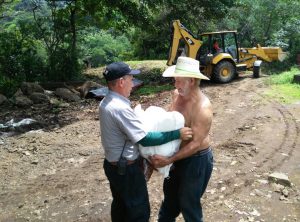 Tropical Storm Nate damaged homes, roads, bridges, and water supplies in and around Monteverde. However, some of the greatest effects in the region occurred in small agriculture-based communities on the southern border of the Children’s Eternal Rainforest (BEN). A number of families in the small towns of Bajo Caliente and San Martin (Montes de Oro, Puntarenas) lost their homes and belongings due to the storm, and many others were stranded and/or left without potable water or access to their farms. .
Tropical Storm Nate damaged homes, roads, bridges, and water supplies in and around Monteverde. However, some of the greatest effects in the region occurred in small agriculture-based communities on the southern border of the Children’s Eternal Rainforest (BEN). A number of families in the small towns of Bajo Caliente and San Martin (Montes de Oro, Puntarenas) lost their homes and belongings due to the storm, and many others were stranded and/or left without potable water or access to their farms. .
Monteverde Conservation League staff in La Tigra de San Carlos – which fortunately was not affected by Nate – immediately began collecting donations to help families in need. Neighbors and local businesses quickly chipped in to support the cause. The donations received were abundant and varied, and in short order MCL staff had amassed what looked like a small grocery and second-hand store at the home of Hernan Chacón (BEN’s Head of Protection) and Ligia Villegas.
Thanks to these generous contributions, we were able to assemble 35 nonperishable food donations, each of which contained enough for one family for about 3 days. In addition to nonperishables, the donations included kitchen and household items, clothing, food for pets and livestock, vegetables donated by local farmers, and fuel for vehicles to travel to the affected areas. MCL staff made 3 trips to communities in need – including Bajo Caliente (photo, below), San Martin, and also Cuajiniquil (La Cruz, Guanacaste) to deliver the donations.
The conservation of the Children’s Eternal Rainforest, like all natural resources, depends largely on the cooperation and support of the communities surrounding the reserve. We feel a great connection and commitment to these communities. In addition to our work conserving and protecting natural resources, we are honored and humbled to also support our neighbors and friends.
As we say in Costa Rica, “manos que dan, nunca estarán vacias” (hands that give, will never be empty).
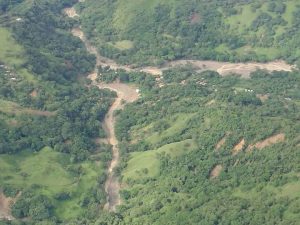
By Lindsay Stallcup, MCL Executive Director.
The post Recovering from Nate: Communities surrounding the BEN appeared first on ACMCR.
]]>Deprecated: Creation of dynamic property WP_Term::$cat_ID is deprecated in /home2/acmhosting/public_html/content/wp-includes/category.php on line 378
Deprecated: Creation of dynamic property WP_Term::$category_count is deprecated in /home2/acmhosting/public_html/content/wp-includes/category.php on line 379
Deprecated: Creation of dynamic property WP_Term::$category_description is deprecated in /home2/acmhosting/public_html/content/wp-includes/category.php on line 380
Deprecated: Creation of dynamic property WP_Term::$cat_name is deprecated in /home2/acmhosting/public_html/content/wp-includes/category.php on line 381
Deprecated: Creation of dynamic property WP_Term::$category_nicename is deprecated in /home2/acmhosting/public_html/content/wp-includes/category.php on line 382
Deprecated: Creation of dynamic property WP_Term::$category_parent is deprecated in /home2/acmhosting/public_html/content/wp-includes/category.php on line 383
The post Tropical Storm Nate in Monteverde appeared first on ACMCR.
]]>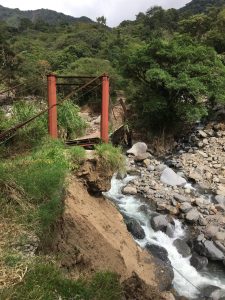
By the time Nate hit, it had already been raining for more than 2 weeks straight. The storm knocked out power, potable water, and phone service. As rain continued to fall on already saturated soils, water-logged hillsides began to give way. Streams jumped their borders, sweeping away roads and bridges (such as the Buen Amigo bridge, at left). Neighbors in Monteverde and nearby San Luis were stranded as landslides took out roads. Several homes in Monteverde were lost.
Fortunately no one was injured during the storm, thanks in great part to the excellent coordination and super-human efforts of the local emergency commission. Neighbors gathered to help one another and to hear the latest updates from the emergency commission. Services were restored and roads opened in what seemed like record time, although long-term road repairs will take much longer.
Here at the Children’s Eternal Rainforest, we were incredibly fortunate in that no buildings were damaged. During a workshop on Adaptation to Climate Change earlier this year, the MCL identified increased heavy rainfall and high wind events as the climate change-related threats likely to have the greatest impact on the CER. As a result of this process, we had implemented preventative measures, such as improving drainage and trimming trees along roads and near buildings. Thanks to these efforts, the damage caused by Nate was much less than it otherwise might have been.
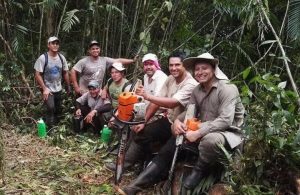 The CER sustained the most damage in San Gerardo, where Nate brought hurricane-like winds in addition to heavy rainfall. The road to San Gerardo and the trails near the field station were damaged by flooded streams, landslides, and fallen trees. Heavy machinery was necessary to install culverts and remove multiple landslides. Chain saws and manual labor were crucial in removing tree and branch falls on the road and trails (photo, right). At one point we had 11 workers and 4 chainsaws operating at the same time! To date, the MCL has invested more than 600 hours of manual labor by our personnel, in addition to the cost of materials and heavy machinery.
The CER sustained the most damage in San Gerardo, where Nate brought hurricane-like winds in addition to heavy rainfall. The road to San Gerardo and the trails near the field station were damaged by flooded streams, landslides, and fallen trees. Heavy machinery was necessary to install culverts and remove multiple landslides. Chain saws and manual labor were crucial in removing tree and branch falls on the road and trails (photo, right). At one point we had 11 workers and 4 chainsaws operating at the same time! To date, the MCL has invested more than 600 hours of manual labor by our personnel, in addition to the cost of materials and heavy machinery.
We are grateful to our neighbors and members for their support in repairing the road to the field station and neighboring farms. Although additional road repairs are still necessary, we are pleased to report that San Gerardo Station is once again up and running!
Our thoughts are with the people throughout Central America who are still in the process of recovering from this destructive storm.
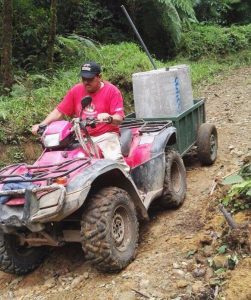
The post Tropical Storm Nate in Monteverde appeared first on ACMCR.
]]>